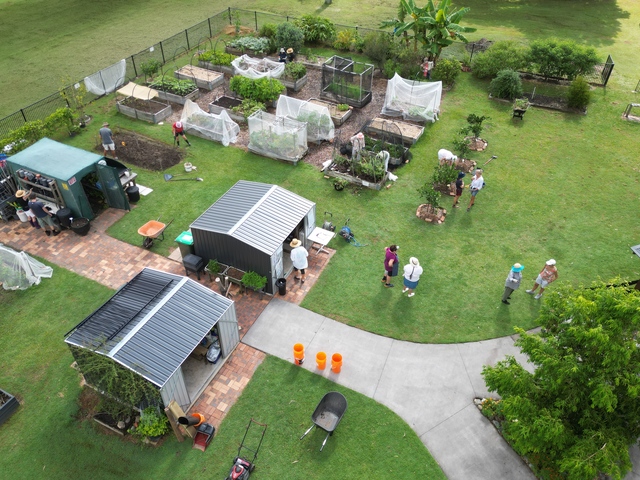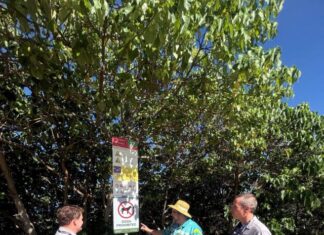Noosa’s Community Garden sits peacefully on the hill at Wallace Park in Noosaville, nestled behind the library and leisure centre.
Depending on the time of year it’s an eclectic mix of fruit trees, vines, bushes and sprouting crops. Members meet every Friday morning for a working bee, which ends with a group morning tea and sharing of any produce harvested.
“The garden is more than a garden.” Says Doug, the group’s president. “It gives members the chance to do some exercise, enjoy watching crops grow and thrive, or even discussing and problem-solving why sometimes our crops are less successful. But just as importantly, it is also a social time where we can get together.”
The gardeners also experiment with growing exotic and unusual crops that aren’t seen in the local supermarkets. “Every week is a discovery of what we can grow and learning about cooking and eating what is in season.”
“Through gardening we get to experience the direct impact of changes in weather and climate.” Doug adds. “Each year is slightly different. Last summer was definitely wetter for example and crops that maybe didn’t do well then are thriving now, and vis-versa.”
“We also hope we are making a small impact on our environment.” adds Erika, a founding member. The garden is fully organic, and members are proud that by growing locally, their ‘food miles’ are reduced. Less food miles means less fossil fuel needed to transport food from farms to supermarkets. In recognition of their efforts, the garden received the Snail of Approval award from the Slow Food Movement in 2024.
The garden also helps address food waste, which contributes about 5% to the shire’s emissions. According to the Noosa Council, up to 38% of our food scraps and organic garden waste goes into landfill. The Community Garden encourages its members and nearby residents to drop off their food scraps at the bins on site. Then over a few weeks, the gardeners turn these scraps into rich compost for the garden beds. There are currently four compost bays but plans are afoot to double this capacity.
In addition to composting, worm farming is an element of the garden’s environmental story. The worm farm turns food scraps into nutritious worm poo which feeds the plants. This, together with composting, contributes in a small way to stopping food scraps going into landfill and producing harmful methane gases.
Similarly, locals can drop off cans and bottles which go to Containers for Change. In 2024 the group collected close to 6,000 bottles which resulted in almost $600 for the group.
Noosa Community Garden only reestablished itself at its current location in 2022 after moving from Earl Street, but in a couple of years it has flourished. It is just one of hundreds of such gardens across Australia, with three in the Noosa Shire. The other two are at Cooroy and Peregian, with others nearby on the Sunshine Coast in Eumundi, Yandina and Mudjimba.
As well as the benefits already mentioned, such gardens can help in a small way to reduce our carbon footprint by providing green spaces with healthy soil and plants that are better able to sequester carbon; and the flowering plants promote local biodiversity of pollinators such as bees and butterflies.
To find out more about a community garden near you go to communitygarden.org.au.
Zero Emissions Noosa (ZEN) Inc. is committed to reducing local emissions and we work closely with the Noosa Council on many of our projects. Find out more at zeroemissionsnoosa.com.au or follow us out on FaceBook







